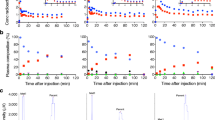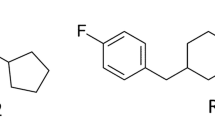Abstract
Purpose
There is growing recognition of the importance of integrating drug occupancy data acquired by positron emission tomography (PET) with the plasma pharmacokinetics of the drug, in order to establish proper dose selection in subsequent clinical trials. Here we present a study in human subjects of the occupancy of NK1 receptors achieved following different doses of casopitant, a selective NK1 antagonist.
Methods
Two PET scans were carried out in each of eight human subjects, with the PET radioligand [11C]GR205171, a high-affinity and selective NK1 receptor antagonist. The first scan was under baseline conditions and the second 24 h after a single oral dose of casopitant (2–120 mg). Arterial blood was collected throughout the scans for determination of plasma and whole blood input functions. Venous blood samples were taken prior to and following oral dosing up to 24 h for a pharmacokinetic study of casopitant concentration in plasma.
Results
It was first necessary to establish a suitable kinetic model for the estimation of [11C]GR205171 NK1 receptor binding parameters in human brain tissue. A three-tissue compartment model with simultaneous estimation of multiple regions sharing common variables across regions was found suitable for the analysis. Because of the injected cold mass of the tracer and the high affinity of [11C]GR205171 a correction for tracer occupancy effects was also incorporated into the analysis. We then developed a pharmacokinetic-receptor occupancy (PK-RO) model of the relationship between casopitant plasma concentrations and receptor binding, using a population approach.
Conclusion
These results indicate that after chronic dosing, casopitant can achieve a degree of NK1 receptor occupancy higher than those that have previously been tested in studies of clinical depression.



Similar content being viewed by others
References
Mantyh PW. Neurobiology of substance P and NK1 receptor. J Clin Psychiatry 2002;63:6–10.
Chahl LA. Tachykinins and neuropsychiatric disorders. Curr Drug Targets 2006;7:993–1003.
Kramer MS, Cutler N, Feighner J, Shrivastava R, Carman J, Sramek JJ, et al. Distinct mechanism for antidepressant activity by blockade of central substance P receptors. Science 1998;281:1640–5.
Kramer MS, Winokur A, Kelsey J, Preskorn SH, Rothschild AJ, Snavely D, et al. Demonstration of the efficacy and safety of a novel substance P (NK1) receptor antagonist in major depression. Neuropsychopharmacology 2004;29:385–92.
Furmark T, Appel L, Michelgård A, Wahlstedt K, Åhs F, Zancan S, et al. Cerebral blood flow changes after treatment of social phobia with the neurokinin-1 antagonist GR205171, citalopram, or placebo. Biol Psychiatry 2005;58:132–42.
Hargreaves R. Imaging substance P receptors (NK1) in the living human brain using positron emission tomography. J Clin Psychiatry 2002;63:18–24.
Bergström M, Hargreaves RJ, Burns HD, Goldberg MR, Sciberras D, Reines SA, et al. Human positron emission tomography studies of brain neurokinin 1 receptor occupancy by aprepitant. Biol Psychiatry 2004;55:1007–12.
Bergström M, Fasth KJ, Kilpatrick G, Ward P, Cable KM, Wipperman MD, et al. Brain uptake and receptor binding of two [11C]labelled selective high affinity NK1- antagonists, GR203040 and GR205171—PET studies in rhesus monkey. Neuropharmacology 2000;39:664–70.
Keller M, Montgomery S, Ball W, Morrison M, Snavely D, Liu G, et al. Lack of efficacy of the substance p (neurokinin1 receptor) antagonist aprepitant in the treatment of major depressive disorder. Biol Psychiatry 2006;59:216–23.
Spinks TJ, Jones T, Bloomfield PM, Bailey DL, Miller M, Hogg D, et al. Physical characteristics of the ECAT EXACT3D positron tomograph. Phys Med Biol 2000;45:2601–18.
Luthra SK, Osman S, Turton DR, Vaja V, Dowsett K, Brady F. An automated system based on solid phase extraction and HPLC for the routine determination in plasma of unchanged [11C]-L-deprenyl; [11C]diprenorphine; [11C]flumazenil; [11C]raclopride; and [11C]Scherring-23390. J Labelled Comp Radiopharm 1993;32:518–20.
Cunningham VJ, Rabiner EA, Matthews JC, Gunn RN, Zamuner S, Gee AD. Kinetic analysis of neuroreceptor binding using PET. Int Congr Ser 2004;1265:12–24.
Innis RB, Cunningham VJ, Delforge J, Fujita M, Gjedde A, Gunn RN, et al. Consensus nomenclature for in vivo imaging of reversibly binding radioligands. J Cereb Blood Flow Metab 2007;27:1533–9.
Lammertsma AA, Hume SP. Simplified reference tissue model for PET receptor studies. Neuroimage 1996;4:153–8.
Hurvich CM, Tsai C-L. Regression and time series model selection in small samples. Biometrika 1989;76:297–307.
Schwarz GE. Estimating the dimension of a model. Ann Stat 1978;6:461–4.
Griffante C, Carletti R, Andreetta F, Corsi M. [3H]GR205171 displays similar NK1 receptor binding profile in gerbil and human brain. Br J Pharmacol 2006;148:39–45.
Ashworth S, Rabiner EA, Gunn RN, Plisson C, Wilson AA, Comley RA, et al. Evaluation of 11C-GSK189254 as a novel radioligand for the H3 receptor in humans using PET. J Nucl Med 2010;51:1021–9.
Pellegatti M, Bordini E, Fizotti P, Roberts A, Johnson BM. Disposition and metabolism of radiolabeled casopitant in humans. Drug Metab Dispos 2009;37:1635–45.
Abanades S, van der Aart J, Barletta JA, Marzano C, Searle GE, Salinas CA, et al. Prediction of repeat-dose occupancy from single-dose data: characterisation of the relationship between plasma pharmacokinetics and brain target occupancy. J Cereb Blood Flow Metab 2011;31:944–52.
Uchizono JA, Lane JR. Empirical pharmacokinetic/pharmacodynamic models. In: Ette EI, Williams PJ, editors. Pharmacometrics: the science of quantitative pharmacology. New York: Wiley; 2007. p. 529–545.
Beal SL, Sheiner LB, editors. NONMEM users guides. NONMEM Project Group. San Francisco: University of California at San Francisco; 1998.
Karlsson MO, Sheiner LB. The importance of modeling interoccasion variability in population pharmacokinetic analyses. J Pharmacokinet Biopharm 1993;21:735–50.
White DB, Walawander CA, Liu DY, Grasela TH. Evaluation of hypothesis testing for comparing two populations using NONMEM analysis. J Pharmacokinet Biopharm 1992;20:295–313.
Karlsson MO, Savic RM. Diagnosing model diagnostics. Clin Pharmacol Ther 2007;82:17–20.
Zamuner S, Gomeni R, Bye A. Estimate the time varying brain receptor occupancy in PET imaging experiments using non-linear fixed and mixed effect modeling approach. Nucl Med Biol 2002;29:115–23.
Slifstein M, Parsey RV, Laruelle M. Derivation of [(11)C]WAY-100635 binding parameters with reference tissue models: effect of violations of model assumptions. Nucl Med Biol 2000;27:487–92.
Hirvonen J, Terry GE, Halldin C, Pike VW, Innis RB. Approaches to quantify radioligands that wash out slowly from target organs. Eur J Nucl Med Mol Imaging 2010;37:917–9.
Sanabria-Bohórquez SM, Van Laere K. Quantitative PET imaging of radioligands with slow kinetics in human brain. Eur J Nucl Med Mol Imaging 2010;37:1613–5.
Zamuner S, Johnson BM, Pagliarusco S, Fina P, Peroni M, Fiore M, et al. Effect of single and repeat doses of casopitant on the pharmacokinetics of CYP450 3A4 substrates midazolam and nifedipine. Br J Clin Pharmacol 2010;70:537–46.
Ranga K, Krishnan R. Clinical experience with substance P receptor (NK1) antagonists in depression. J Clin Psychiatry 2002;63:25–9.
Conflicts of interest
All of the authors of this paper are or have been employees of GlaxoSmithKline who sponsored the study.
Author information
Authors and Affiliations
Corresponding author
Rights and permissions
About this article
Cite this article
Zamuner, S., Rabiner, E.A., Fernandes, S.A. et al. A pharmacokinetic PET study of NK1 receptor occupancy. Eur J Nucl Med Mol Imaging 39, 226–235 (2012). https://doi.org/10.1007/s00259-011-1954-2
Received:
Accepted:
Published:
Issue Date:
DOI: https://doi.org/10.1007/s00259-011-1954-2




